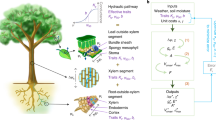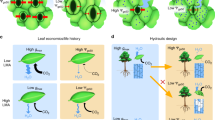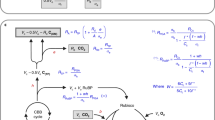Abstract
The widely used theory for gas exchange proposed by von Caemmerer and Farquhar (vCF) integrates molar fluxes, mole fraction gradients and ternary effects but does not account for cuticular fluxes, for separation of the leaf surface conditions or for ternary effects within the boundary layer. The magnitude of cuticular conductance to water (gcw) is a key factor for determining plant survival in drought but is difficult to measure and often neglected in routine gas exchange studies. The vCF ternary effect is applied to the total flux without the recognition of different pathways that are affected by it. These simplifications lead to errors in estimations of stomatal conductance, intercellular carbon dioxide concentration (Ci) and other gas exchange parameters. The theory presented here is a more precise physical approach to the electrical resistance analogy for gas exchange, resulting in a more accurate calculation of gas exchange parameters. Additionally, we extend our theory, using physiological concepts, to create a model that allows us to calculate cuticular conductance to water.
This is a preview of subscription content, access via your institution
Access options
Access Nature and 54 other Nature Portfolio journals
Get Nature+, our best-value online-access subscription
$29.99 / 30 days
cancel any time
Subscribe to this journal
Receive 12 digital issues and online access to articles
$119.00 per year
only $9.92 per issue
Buy this article
- Purchase on Springer Link
- Instant access to full article PDF
Prices may be subject to local taxes which are calculated during checkout





Similar content being viewed by others
Data availability
All generated and analysed data from this study are included in the published article, its Supplementary Information and in the GitHub repository (https://github.com/PlantPhysiologist/When_small_fluxes_matter-calculating-leaf-gas-exchange). Source data are provided with this paper.
Change history
19 April 2021
A Correction to this paper has been published: https://doi.org/10.1038/s41477-021-00899-w
References
von Caemmerer, S. & Farquhar, G. D. Some relationships between the biochemistry of photosynthesis and the gas exchange of leaves. Planta 153, 376–387 (1981).
Gaastra, P. Photosynthesis of Crop Plants as Influenced by Light, Carbon Dioxide, Temperature, and Stomatal Diffusion Resistance (H. Veenman, 1959).
Sheriff, D. W. Epidermal transpiration and stomatal responses to humidity: some hypotheses explored. Plant Cell Environ. 7, 669–677 (1984).
Boyer, J. S. & Kawamitsu, Y. Photosynthesis gas exchange system with internal CO2 directly measured. Environ. Control Biol. 49, 193–207 (2011).
Holmgren, P., Jarvis, P. & Jarvis, M. Resistances to carbon dioxide and water vapour transfer in leaves of different plant species. Physiol. Plant. 18, 557–573 (1965).
Boyer, J. S., Wong, S. C. & Farquhar, G. D. CO2 and water vapor exchange across leaf cuticle (epidermis) at various water potentials. Plant Physiol. 114, 185–191 (1997).
Choat, B. et al. Triggers of tree mortality under drought. Nature 558, 531–539 (2018).
Blackman, C. J. et al. Toward an index of desiccation time to tree mortality under drought. Plant Cell Environ. 39, 2342–2345 (2016).
Hanson, D., Stutz, S. S. & Boyer, J. S. Why small fluxes matter: the case and approaches for improving measurements of photosynthesis and (photo) respiration. J. Exp. Bot. 67, 3027–3039 (2016).
Mizokami, Y., Noguchi, K., Kojima, M., Sakakibara, H. & Terashima, I. Mesophyll conductance decreases in the wild type but not in an ABA-deficient mutant (aba1) of Nicotiana plumbaginifolia under drought conditions. Plant Cell Environ. 38, 388–398 (2015).
Boyer, J. S. Impact of cuticle on calculations of the CO2 concentration inside leaves. Planta 242, 1405–1412 (2015).
Tominaga, J. & Kawamitsu, Y. Cuticle affects calculations of internal CO2 in leaves closing their stomata. Plant Cell Physiol. 56, 1900–1908 (2015).
Duursma, R. A. et al. On the minimum leaf conductance: its role in models of plant water use, and ecological and environmental control. New Phytol. 221, 693–705 (2018).
Boyer, J. S. Turgor and the transport of CO2 and water across the cuticle (epidermis) of leaves. J. Exp. Bot. 66, 2625–2633 (2015).
Tominaga, J., Shimada, H. & Kawamitsu, Y. Direct measurement of intercellular CO2 concentration in a gas-exchange system resolves overestimation using the standard method. J. Exp. Bot. 69, 1981–1991 (2018).
Wong, S. C., Cowan, I. R. & Farquhar, G. D. Leaf conductance in relation to assimilation in Eucalyptus pauciflora Sieb. ex Spreng: influence of irradiance and partial pressure of carbon dioxide. Plant Physiol. 62, 670–674 (1978).
Wong, S. C., Cowan, I. R. & Farquhar, G. D. Leaf conductance in relation to rate of CO2 assimilation I. Influence of nitrogen nutrition, phosphorus nutrition, photon flux density, and ambient partial pressure of CO2 during ontogeny. Plant Physiol. 78, 821–825 (1985).
Farquhar, G. D. & Sharkey, T. D. Stomatal conductance and photosynthesis. Annu. Rev. Plant Physiol. 33, 317–345 (1982).
Moss, D. N. & Rawlins, S. L. Concentration of carbon dioxide inside leaves. Nature 197, 1320–1321 (1963).
Massman, W. J. A review of the molecular diffusivities of H2O, CO2, CH4, CO, O3, SO2, NH3, N2O, NO, and NO2 in air, O2 and N2 near STP. Atmos. Environ. 32, 1111–1127 (1998).
Cowan, I. R. Mass and heat transfer in laminar boundary layers with particular reference to assimilation and transpiration in leaves. Agric. Meteorol. 10, 311–329 (1972).
Tredenick, E. C., Farrell, T.W. & Forster, W. A. Mathematical modelling of hydrophilic ionic fertiliser diffusion in plant cuticles: lipophilic surfactant effects. Plants 8, 202 (2019).
Tredenick, E. C., Farrell, T. W. & Forster, W. A. Mathematical modeling of diffusion of a hydrophilic Ionic fertilizer in plant cuticles: surfactant and hygroscopic effects. Front. Plant Sci. 9, 1888 (2018).
Tredenick, E. C., Farrell, T. W., Forster, W. A. & Psaltis, S. T. P. Nonlinear porous diffusion modeling of hydrophilic ionic agrochemicals in astomatous plant cuticle aqueous pores: a mechanistic approach. Front. Plant Sci. 8, 746 (2017).
Ball, J. T. in Stomatal Function (eds Cowan, I. R. et al.) 445–476 (Stanford Univ. Press, 1987).
Syvertsen, J. P., Lloyd, J., McConchie, C., Kriedemann, P. E. & Farquhar, G. D. On the relationship between leaf anatomy and CO2 diffusion through the mesophyll of hypostomatous leaves. Plant Cell Environ. 18, 149–157 (1995).
Mott, K. A. & O’Leary, J. W. Stomatal behavior and CO2 exchange characteristics in amphistomatous leaves. Plant Physiol. 74, 47–51 (1984).
Wong, S. C., Cowan, I. R. & Farquhar, G. D. Leaf conductance in relation to rate of CO2 assimilation II. Effects of short-term exposures to different photon flux densities assimilation. Plant Physiol. 78, 826–829 (1985).
Parkhurst, D. F., Wong, S. C., Farquhar, G. D. & Cowan, I. R. Gradients of intercellular CO2 levels across the leaf mesophyll. Plant Physiol. 86, 1032–1037 (1988).
Wong, S. C., Cowan, I. R. & Farquhar, G. D. Leaf conductance in relation to rate of CO2 assimilation III. Influences of water stress and photoinhibition. Plant Physiol. 78, 830–834 (1985).
Parkhurst, D. F. Diffusion of CO2 and other gases inside leaves. New Phytol. 126, 449–479 (1994).
Farquhar, G. D. & Raschke, K. On the resistance to transpiration of the sites of evaporation within the leaf. Plant Physiol. 61, 1000–1005 (1978).
Hoad, S. P., Grace, J. & Jeffree, C. E. A leaf disc method for measuring cuticular conductance. J. Exp. Bot. 47, 431–437 (1996).
Bakker, J. C. Leaf conductance of four glasshouse vegetable crops as affected by air humidity. Agric. Meteorol. 55, 23–36 (1991).
Kerstiens, G. Cuticular water permeability and its physiological significance. J. Exp. Bot. 47, 1813–1832 (1996).
Cameron, K. D., Teece, M. A. & Smart, L. B. Increased accumulation of cuticular wax and expression of lipid transfer protein in response to periodic drying events in leaves of tree tobacco. Plant Physiol. 140, 176–183 (2006).
Bi, H. et al. The impact of drought on wheat leaf cuticle properties. BMC Plant Biol. 17, 85 (2017).
Schreiber, L. Effect of temperature on cuticular transpiration of isolated cuticular membranes and leaf discs. J. Exp. Bot. 52, 1893–1900 (2001).
Burghardt, M. & Riederer, M. in Biology of the Plant Cuticle Vol. 23 (eds Riederer, M. & Muller, C.) 292–311 (2006).
Zhang, Y. et al. A proposed method for simultaneous measurement of cuticular transpiration from different leaf surfaces in Camellia sinensis. Front. Plant Sci. 11, 420 (2020).
Evans, J., Sharkey, T., Berry, J. & Farquhar, G. Carbon isotope discrimination measured concurrently with gas exchange to investigate CO2 diffusion in leaves of higher plants. Funct. Plant Biol. 13, 281–292 (1986).
Tazoe, Y., von Caemmerer, S., Estavillo, G. M. & Evans, J. R. Using tunable diode laser spectroscopy to measure carbon isotope discrimination and mesophyll conductance to CO2 diffusion dynamically at different CO2 concentrations. Plant Cell Environ. 34, 580–591 (2011).
Busch, F. A., Holloway-Phillips, M., Stuart-Williams, H. & Farquhar, G. D. Revisiting carbon isotope discrimination in C3 plants shows respiration rules when photosynthesis is low. Nat. Plants 6, 245–258 (2020).
Sharkey, T. D., Imai, K., Farquhar, G. D. & Cowan, I. R. A direct confirmation of the standard method of estimating intercellular partial pressure of CO2. Plant Physiol. 69, 657–659 (1982).
Acknowledgements
We thank CONICYT Doctorado, Becas Chile/2015 Folio 72160160 and the Australian Research Council Centre of Excellence for Translational Photosynthesis for funding part of the research. We also thank P. Groeneveld for technical support and building the LI-6800 connector; S. Chin Wong for providing extra minimum conductance data and technical support; and Australian National University Plant Services for taking care of the plant material.
Author information
Authors and Affiliations
Contributions
D.M.A., H.S-W. and G.D.F. conceived the study. D.M.A. undertook the experimental work and data analysis. D.M.A. and G.D.F. carried out the modelling. D.M.A. wrote the manuscript with help from all authors.
Corresponding author
Ethics declarations
Competing interests
The authors declare no competing interests.
Additional information
Peer review information Nature Plants thanks David Hanson, Thomas Sharkey and the other, anonymous, reviewer(s) for their contribution to the peer review of this work.
Publisher’s note Springer Nature remains neutral with regard to jurisdictional claims in published maps and institutional affiliations.
Extended data
Extended Data Fig. 1 Effect of κ on cuticular conductance calculations.
Variation of gcw calculation if the [CO2] at the evaporative sites of the adaxial and abaxial surfaces of the leaf differ (Variation = gcw(κ) - gcw(1)). Differences in [CO2] in the evaporative site of the adaxial and abaxial surfaces impact gas exchange measurements and calculations to different degrees depending on the external measured values. For the purposes of our study, the impact on the gcw calculation was tested by keeping measurements of external gas exchange parameters constant and changing κ.
Extended Data Fig. 2 Average gcw for a C. annuum leaf under different atmospheric conditions (assuming κ = 1).
a, gcw measured under different atmospheric CO2 concentrations (Ca) over 30 minutes after achieving stable conditions (blue dots) and an average of 24 hours under light at constant [CO2] following a diurnal cycle of atmospheric conditions (red dot); and (b) at different temperatures of the leaf and varying relative humidity (RH) also expressed as atmospheric saturation deficits (ASD) for the black dots. In panel (a), each blue point gives the average and standard deviation of 8 to 16 measurements (n); the red point gives the average and standard deviation of 239 measurements (n), one measurement being taken every 4 minutes. In panel (b), each red and blue dot gives the average and standard deviation of 16 to 31 measurements (n), one measurement taken every 2 minutes; black dots are single measurements under stable gas exchange conditions for at least 25 minutes. The measurements were made from low to high ASD and later from high to low ASD. Graphs (a) and (b) are different leaves. Cuticular conductance (gcw) is expressed as the value for one surface and therefore needs to be doubled for the whole leaf (γ = 1).
Extended Data Fig. 3 Effect of possible differences in abaxial and adaxial leaf cuticular conductance.
Impact of unequal adaxial and abaxial gcw in (a) the total cuticular conductance (gcw-T = gcw-ad+gcw-ab) calculated for a leaf and in (b) the Ci calculation, depending on the proportion of abaxial over adaxial cuticular conductance (γ) using as a reference gcw-T calculated with γ=1. A single measurement under stable gas exchange conditions was selected for calculating the variation of each species using κ = 1. The dots show the values using our dark measurements to estimate γ for each species. Zhang et al.40 measured weight loss via cuticle of detached leaves and they concluded that astomatous surfaces have about 30% lower evaporation than the cuticle of the surfaces with stomata. It is difficult to extrapolate these evaporation values to gcw values in growing leaves because the boundary layer conductance and leaf temperature were not provided, and the leaves had already been detached for one hour. Bearing this in mind, we used dark measurements to estimate inequalities between the adaxial and abaxial cuticular conductance, which can be used to quantify a possible gcw difference between the adaxial and adaxial surfaces. Then, assuming equal stomatal closure on the adaxial and abaxial surface, in G. biloba only 6% of the difference in glw was not explained by the stomatal density differences, 8% for G. hirsutum and 15% for C. annuum; the abaxial and adaxial glw of H. annuus were practically the same in the dark. Using equation (18), it was found that significant variations in γ can have a big impact on the calculated total cuticular conductance (gcw-T=gcw-ad+gcw-ab). The magnitude of this impact depends on how much γ affects the wi -ws gradient.
Extended Data Fig. 4 Diagram of the connection of two LI-6800.
Part A: Flanges on the lower cuvette and the second LI-6800. Part B: Lid of the upper cuvette, the lid of the lower cuvette includes two cavities to insert two thermocouples. Part C: Flange to block the flow of gases from and to the lower cuvette.
Supplementary information
Supplementary Information
Supplementary Notes 1–11.
Source data
Source Data Fig. 2
C. annuum cuticular conductance in four leaves.
Source Data Fig. 3
Cuticular conductance for four species.
Source Data Fig. 4
Gas exchange under water stress and stomatal opening.
Source Data Fig. 5
Comparison between Ci calculations.
Source Data Extended Data Fig. 2
Gas exchange at different atmospheric conditions.
Rights and permissions
Springer Nature or its licensor (e.g. a society or other partner) holds exclusive rights to this article under a publishing agreement with the author(s) or other rightsholder(s); author self-archiving of the accepted manuscript version of this article is solely governed by the terms of such publishing agreement and applicable law.
About this article
Cite this article
Márquez, D.A., Stuart-Williams, H. & Farquhar, G.D. An improved theory for calculating leaf gas exchange more precisely accounting for small fluxes. Nat. Plants 7, 317–326 (2021). https://doi.org/10.1038/s41477-021-00861-w
Received:
Accepted:
Published:
Issue Date:
DOI: https://doi.org/10.1038/s41477-021-00861-w
This article is cited by
-
Humidity gradients in the air spaces of leaves
Nature Plants (2022)
-
Dynamics of moisture diffusion and adsorption in plant cuticles including the role of cellulose
Nature Communications (2021)



